When it comes to jeans, it seems like the gulf in prices could not be greater. How can one pair of jeans cost $12 and another pair cost $1,200? Well, finding out why is exactly what we’ll be doing today.
Denim Definitions (& Price Parameters)
Jeans, a hard-wearing, hard-working fabric, rose to prominence on farms and ranges and now also grace high-fashion runways. As such, choices are out in the market for different budgets!
We understand that “cheap” and “expensive” are relative terms. What’s cheap for a dedicated denim head who invests in quality could be considered expensive for someone else. A central feature in our Is It Worth It? series is determining whether iconic articles are worth their high prices.
A pair of designer jeans might cost hundreds of dollars, but the actual manufacturer of the jeans could be comparable to a pair that cost dozens of dollars. Consider also that “cheap” and “expensive” include nuances of quality.
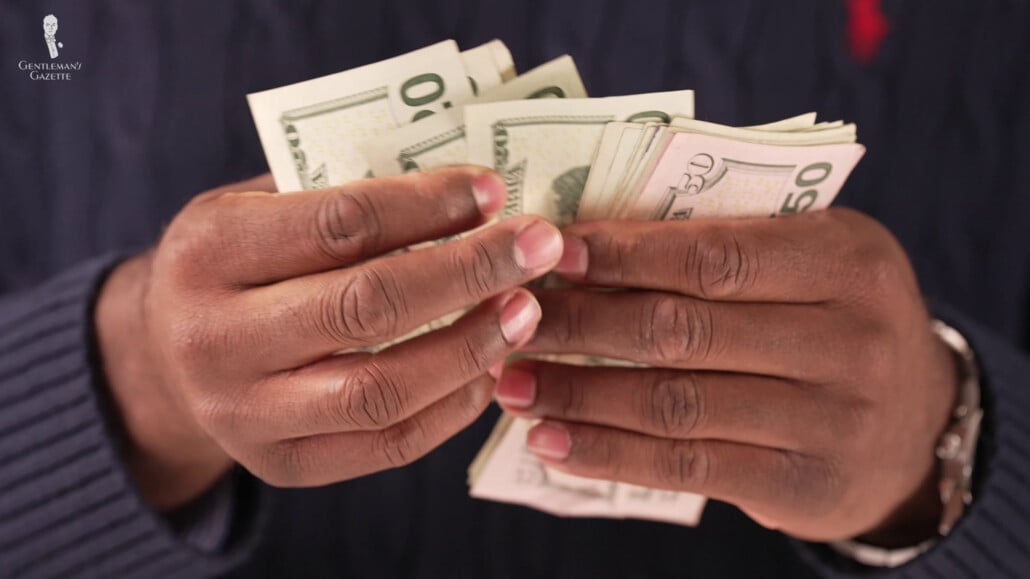
A pair of well-made jeans might have a steep upfront cost, but if they last for decades and return an excellent cost per wear ratio. their expense is justified. Conversely, if you buy low-quality jeans at a very low price but have to replace those genes every few months, you might end up wasting a lot of time and resources.
Finally, the average price of jeans can vary greatly depending on where you live in the world – being generally cheaper in North America and more expensive elsewhere.
Today, we’re defining jeans that retail at $30 or less as cheap and $200 or more as expensive. Again, we recognize that those figures might not exactly reflect your individual finances and priorities. But, we hope that it’s a good fit for today’s discussion.
The Denim Jeans Guide – Their History & How To Buy For Your Body Type
Comparing Fabric
When comparing menswear articles, it helps to start with the basics, such as looking at the fabric.
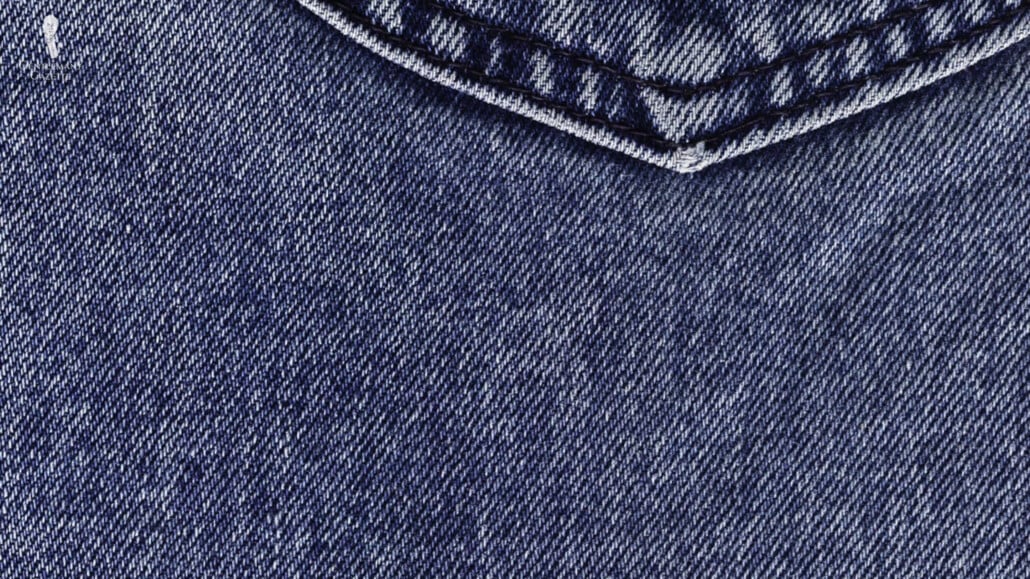
By definition, jeans are made from denim – a fabric made from sturdy cotton that is twill woven with a distinctive diagonal pattern from the twill weave. Denim has been around since the 17th century, but jeans, as we know them today really, came to prominence in the second half of the 19th century – as covered in our assessment of one of the most famous makers of modern jeans, Levi Strauss & Co.
Levi’s 501 Jeans: Are They Worth It? (In-Depth Review)
As a workman’s fabric, denim was valued for its durability and strength. But, as jeans have increasingly become a fashion icon – even getting paired with sport coats – additional qualities like softness, unique texture, and drape have become more important.
For cheaper jeans, manufacturers employ low-quality cotton and often cut it with synthetic fabrics. Not only are synthetics cheaper than 100% cotton, they help ameliorate some of the problems produced by low-quality cotton-like, rougher texture, reduced elasticity, and stiffness.
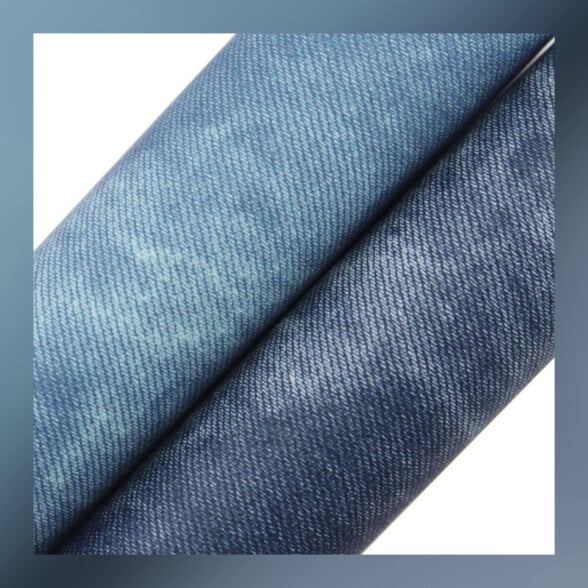
Synthetic Fabrics
Synthetic fabrics are cheaper than 100% cotton. They can be too shiny, can stretch out, and reduce breathability.
Of course, synthetics bring their own host of problems like appearing too shiny, stretching out, and reducing breathability. Cheaper jeans fabrics are also more likely to be cheaply dyed with synthetic dyes that hold color unevenly, fade quickly, or have a slick and somewhat sticky finish. It sounds like cheap fabrics for jeans are both cheap and of rather poor value.
But, it is necessary for high-volume, mass-scale manufacturers to opt for cheap fabrics. Expensive raw materials cut into profit margins. Cotton isn’t necessarily a luxury fabric but, as we covered in our guide, it comes in a variety of quality levels, and improved quality increases prices.
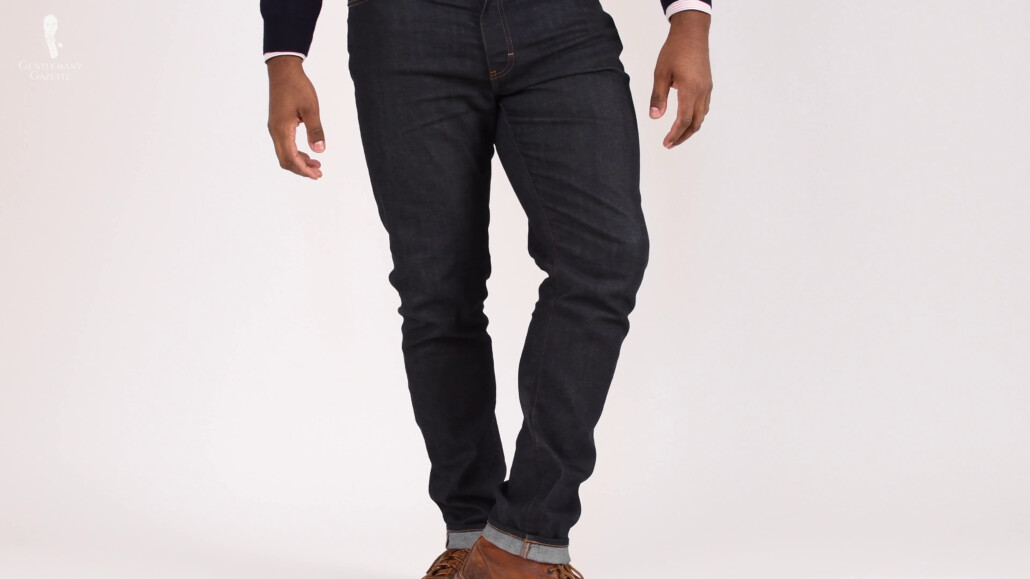
Among expensive jeans, the full potential of high-quality cotton jeans becomes apparent. Expensive jeans are often made from cotton that is softer and more pliable or will become so after several wears after you break them in. They also tend to have a more natural, more flattering drape, and some examples can even partially mold to your body shape. Expensive denim is also recognizable by its beautiful hues as quality dyeing processes allow for the transfer of rich, lustrous, and vibrant color.
Although, quality dyes are not without some issues. Most famously, many indigo dyes can transfer when wet. This inconvenience, however, is a byproduct of the very qualities that make this kind of dye superlative – like strong color and pigment resilience.
You can also find specialty jeans fabrics. Raw denim refers to denim that hasn’t been treated or washed after dying. It has dynamic and vigorous color and a stiff, crinkly hand. Raw denim molds, softens, and elegantly fades as you wear it and is considered by many the epitome of jeans fabric.
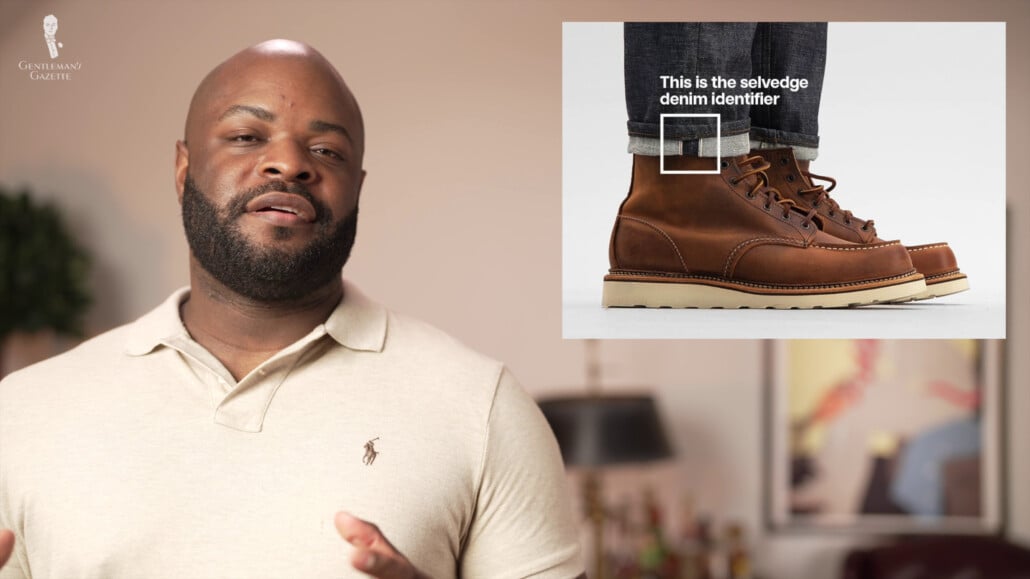
Jeans fabric can also be finished in unique ways like the much-vaunted selvage denim. “Selvage” refers to fabrics that are self-edged or self-finished, and selvedged jeans are immediately recognizable by their interior finished edge. Selvedged denim can only be made on special looms, and, in most cases, anyone going through the trouble of making selvaged denim will not skimp elsewhere.
Expensive jeans are made from expensive fabrics because high-quality fabrics demand a high price. That quality can also require special care and treatment, bringing up our next section.
Comparing Care
It’s no surprise that many menswear items require specialized care and cleaning routines. But, some people are surprised to hear that they might need to handle their jeans with kid gloves. But how you care for your jeans can have a massive impact on their quality, which is exacerbated by the initial price of the jeans.
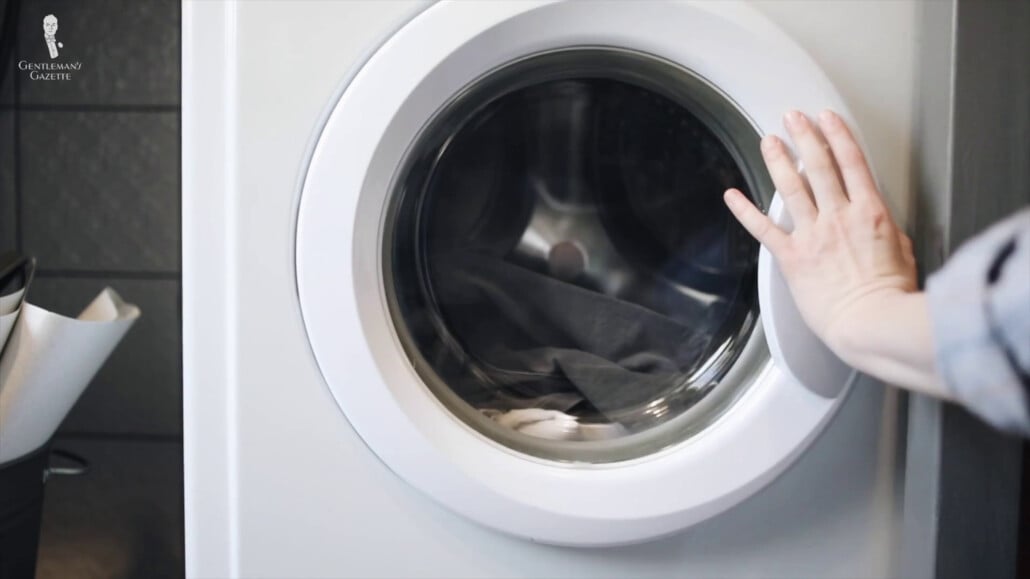
Cheap jeans are usually sold with the understanding that consumers want minimal muss and fuss. These jeans are listed as machine-washable, often even at high temperatures, to remove dirt and grime. However, because of the cheap quality of the jeans fabric, cheap jeans can fade in the wash. They can collapse and become baggy.
Cheap jean fabrics are usually finished to give them a more pleasing drape and hold, but even one washing can strip those finishing agents, leaving the jeans puddling and lank. Cheap jeans are more likely to shrink excessively or develop a slick, unfinished texture, and cheap jeans can even come loose or tear along the seams, especially when knocked around in a dryer.
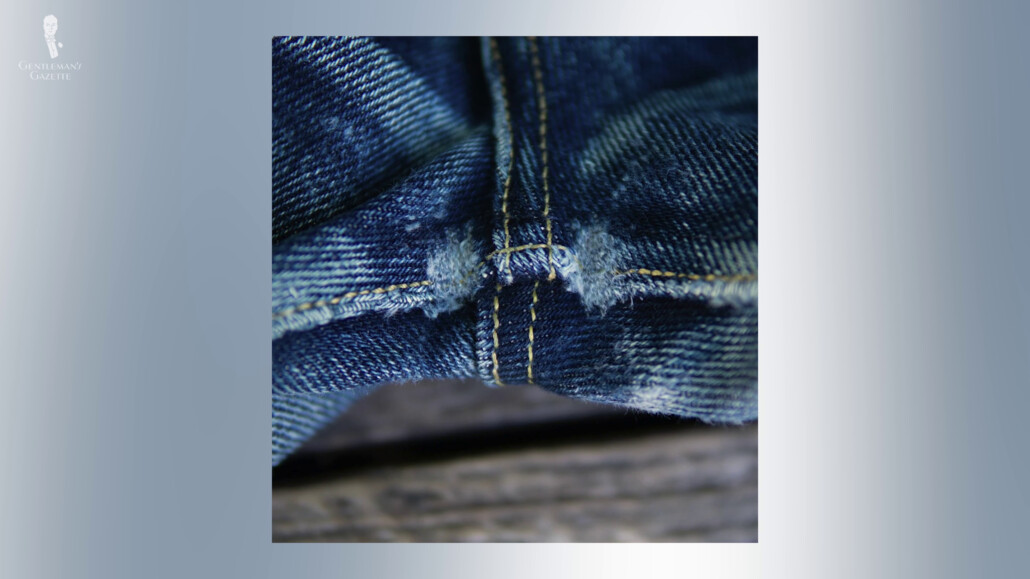
Things get even more complicated with expensive jeans. Remember that raw denim we mentioned? Some purists insist that it should never be washed – only meticulously spot cleaned. Avoiding washing is the only way to keep raw denim rich and vibrant, as it minimizes general fading that will make your jeans appear washed out. It will also create visual interest and contrast between areas of natural fading like stress points at the knees and the body of the jeans, which will retain their lustrous original hue.
We recognize, however, that, for many people, this is not practical, in which case, you can follow the precise care instructions outlined in our washing guide.
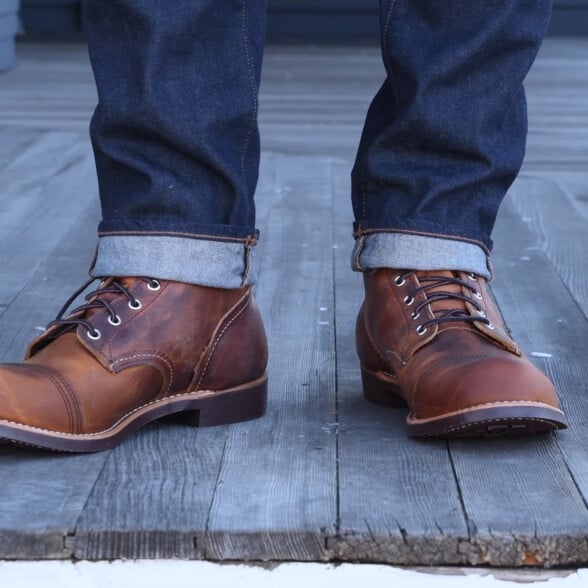
Breaking-in Period
Expensive jeans will need multiple wears before becoming soft and pliable, just like a good pair of shoes.
Expensive jeans can also require a longer breaking-in period, requiring multiple wears before becoming soft and pliable. Although like a good pair of shoes, breaking in jeans like these will produce a superior fit, comfort, and feel.
These proliferations of rules regarding expensive denim can be confusing. But, the fact of the matter is such steps are necessary to maintain the quality that makes denim jeans such a valued item. And while expensive jeans can be difficult to care for, that investment of care will allow you to enjoy the superlative qualities of your jeans for much longer.
Comparing Construction & Features
Along with fabric, the cost of manufacturing jeans represents one of the biggest capital investments, and construction methods can vary greatly between cheap and expensive jeans.
Cheap jeans are almost entirely produced in developing nations. Reduced labor costs make cheap prices feasible. Patterns for these jeans are often flat and poorly designed, meaning that, when actually worn, jeans can sit uncomfortably, bunch, puddle, and generally look unappealing and feel uncomfortable because they weren’t patterned and sewn with good fit in mind.
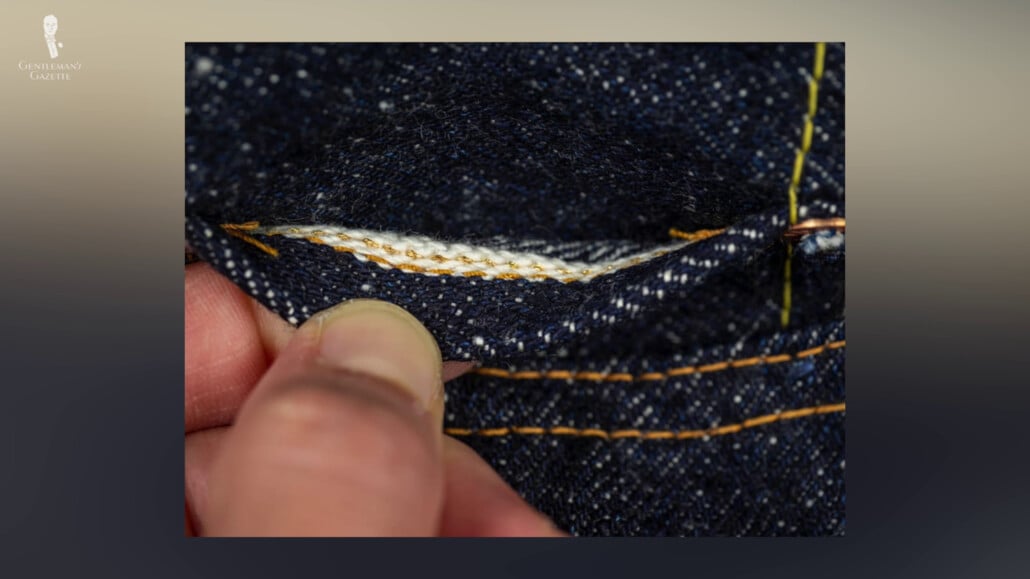
Cheap jeans will usually have low-quality stitching with low stitch densities and cheap thread that easily breaks and looks ragged. It can sometimes compromise the seams of the jeans themselves. In addition to skimping on fabric and labor, cheap jean manufacturers will also cut corners on other materials like metal rivets.
Rivets were originally designed to reinforce stress points on jeans, increasing their longevity. On cheap jeans, these rivets are mostly cosmetic, serving no structural purpose, often appearing dull, tarnished, and cheap-looking.
Some cheaply-applied rivets can even stain and damage the fabric around them., ironically doing the exact opposite of their original intended purpose. And don’t get us started on cheap zippers that come off the track, break off, or freeze up!
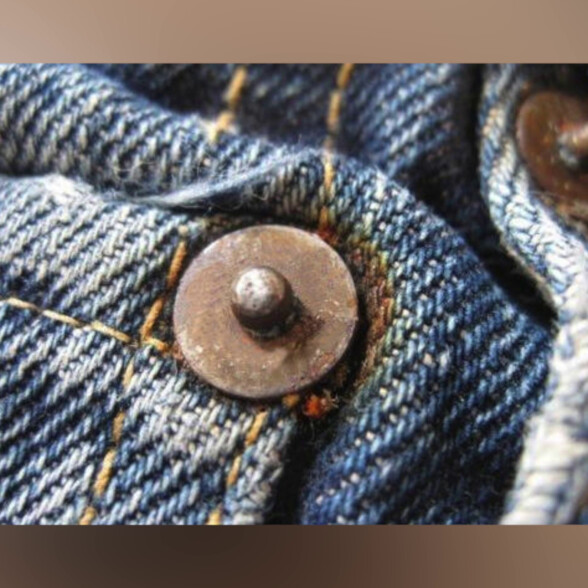
Cheap Rivets
Rivets on cheap jeans are mostly cosmetic. They often appear dull, tarnished and cheap-looking.
Image Credit: India Mart
Construction also plays a major role in functional and aesthetic features. For jeans, one of the most important features is pockets. On cheap jeans, there will usually be a minimum of three to four pockets, usually two in the front and one or two in the back.
For most of us, that’s probably enough. But, because of poor design execution, many of these pockets don’t actually work because they’ve been improperly sewn and applied. Pockets that are too small or tight to hold items like a wallet, your keys, or your phone – or that do so but create an unsightly bulge or outline. Might as well not be there at all.
Cheap jeans usually have poorly thought-out production because design and labor represent a major sink for resources, and, to maintain a lower price point, construction has to be bare bones.
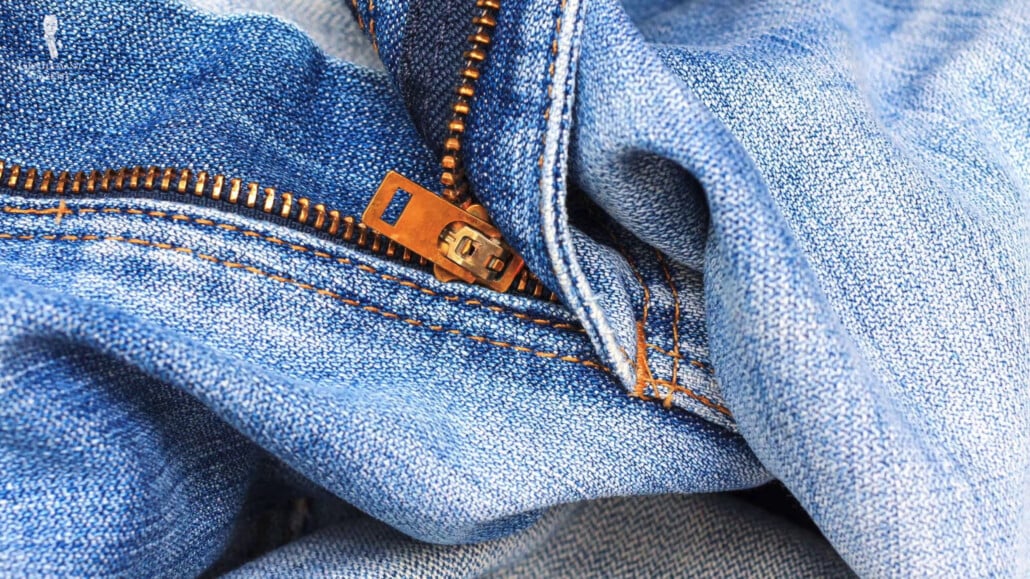
On expensive jeans, greater attention will be paid to the overall design. Patterns will be cut to ensure a comfortable, sculpted, and movable fit, and jeans will be assembled with a greater emphasis on quality control.
We’re not saying that expensive denim is always handmade by artisanal craftsmen. But, in general, at expensive prices, you can expect finer detailing like organic, elastic pattern assembly, excellent stitching, available in interesting complementary colors for added visual interest, and features that work; rivets will actually function or, at the very least, be more visually pleasing, zippers will slide without issue, and pockets, often available in more arrangements, will hold your items securely without appearing bulky. You can even put a pocket watch in that little pocket.
Comparing Fit
In addition to how construction affects how the jeans lay on your body, jeans are also cut to fit certain styles. To ensure general appeal, cheaper jeans are usually only available in mid or low-rise. The popular perception is that these rises are more comfortable and appealing. Even though, when properly sized and fitted, high-waisted jeans, like higher-waisted trousers in general, are ideal for most men.
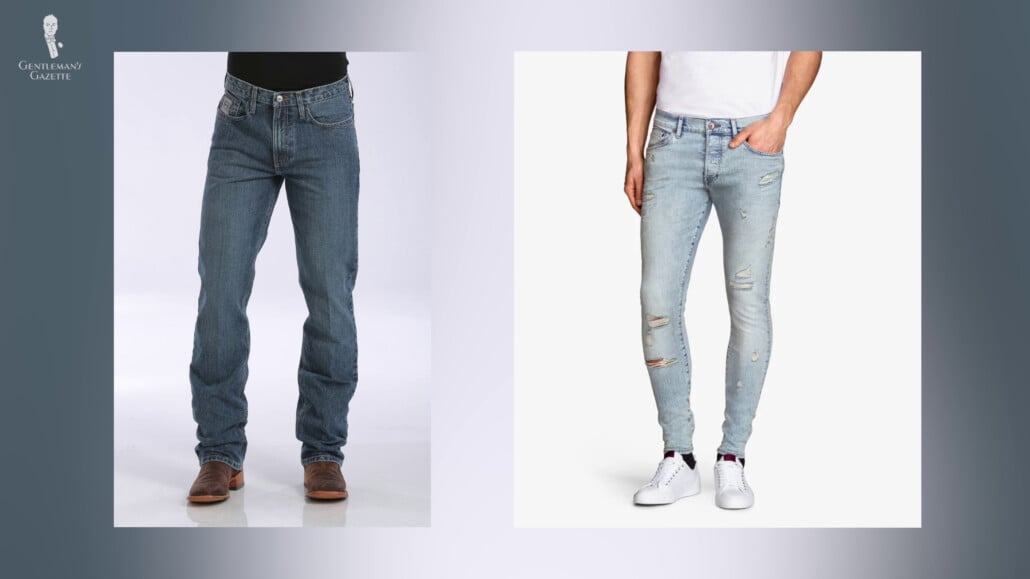
When dealing with razor-thin margins, we suspect that the manufacturers of cheap jeans also prefer lower-rise jeans because they are easier to make and require less material. Lower costs also make cheaper jeans more responsive to trends.
When jeans can be pumped out inexpensively and easily, they’re better able to keep up with whatever the latest fad is. However, to avoid retooling factories, this often means that cheaper jeans can only be found in trendy cuts, making it more difficult to find cuts that actually work with your body.
How to Dress for Your Body Type
Cheap jeans favor unflattering or trendy cuts because they are easier to make and they’re also easier to sell. And when jeans have to appeal to the mass market, cheap jean manufacturers will ignore timeless, classic cuts, and go all in on whatever will sell most quickly.
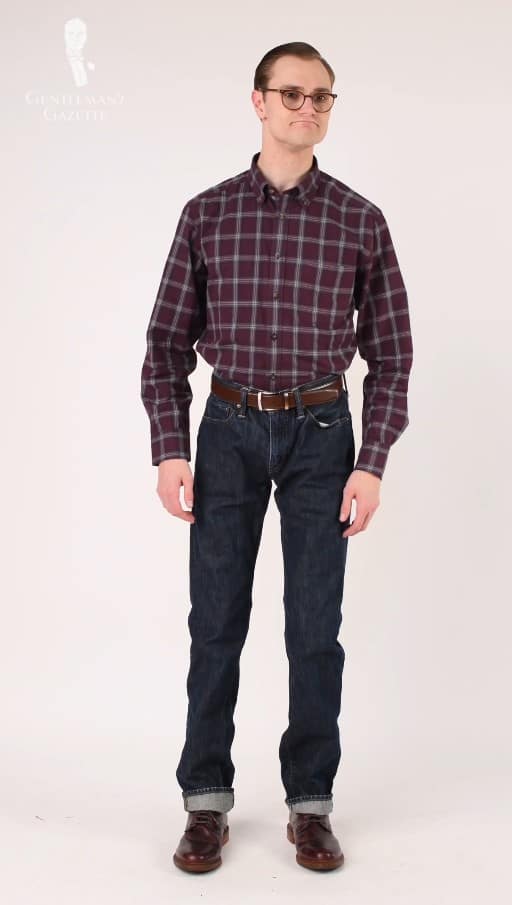
Expensive jeans can be made available in a much wider range of cuts because designers have a greater emphasis on what actually works and is comfortable, rather than what can be sold cheaply and quickly. You’re much more likely to find classic cuts available at expensive jean retailers.
Because of higher upfront costs, most expensive jeans are designed to follow more middle-of-the-road, timeless styles, so they can be sold at any time, regardless of trends. Of course, a big exception to this rule will be designer jeans.
Conclusion
Having outlined the main differences between cheap and expensive jeans, we can make some general conclusions. Cheap jeans tend to produce an inferior wearing experience. Low-quality fabric construction is uncomfortable and unappealing, and cheap jeans tend to be perhaps a little too rough – even for those famously rough-wearing garments.
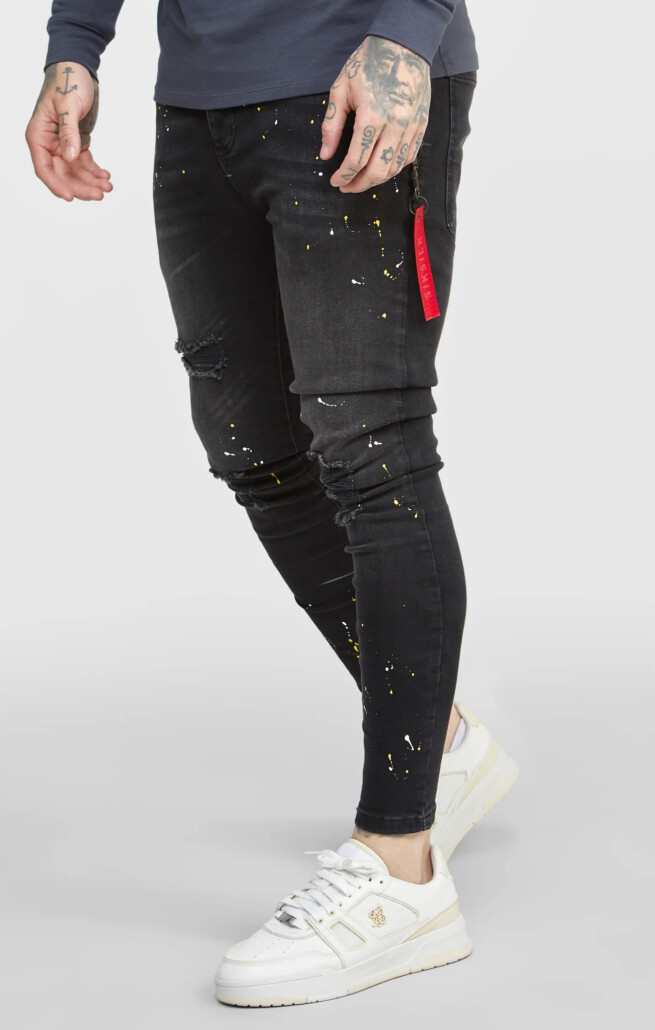
Expensive jeans, on the other hand, offer a unique and exceptional wearing experience that really highlights the sartorial potential of jeans, but at an increased cost of not only money, but also time and attention for adequate care and maintenance.
Ultimately, the right jeans for you will depend on why you want the jeans.
If you’re primarily interested in jeans as a hard-wearing, reliable trouser for doing chores and work around the house, your main concerns will likely be comfort and durability, and moderately priced or even cheap jeans could be the answer to your needs.
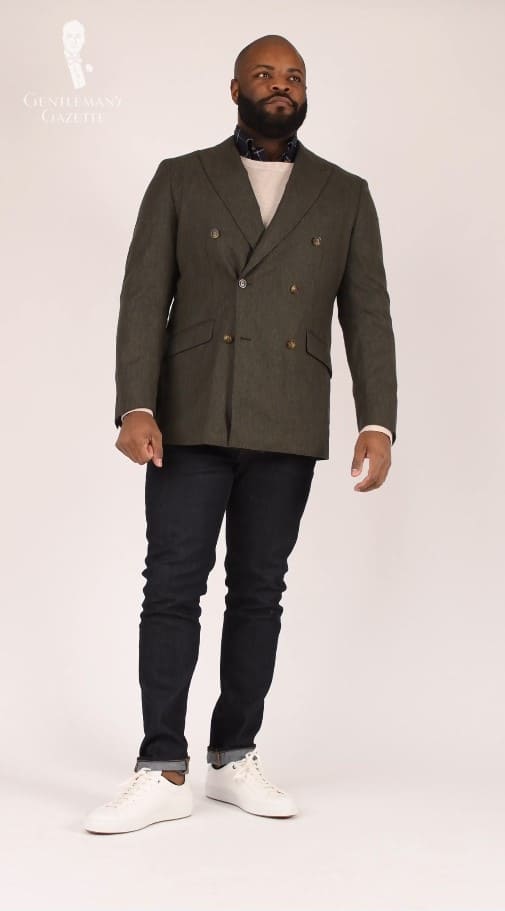

If you want your jeans to be a regular feature in your wardrobe, especially when styled as a centerpiece and a classic ensemble, the rich colors and unique textures of expensive jeans might be worth the extra effort to care for them.
Ultimately, good denim is whatever denim is good for you and is diametric between cheap and expensive jeans. We left a sizable mid-range of between $30 and $200, which might be a sweet spot for you as well.
What do you think? Let us know in the comments if you regularly shell out for expensive jeans or if you think spending more than $30 on jeans is crazy!
Outfit Rundown
Today, I’m wearing a tan Ralph Lauren polo with a pair of dark wash denim, brown chukka boots, and some brown shadow stripe socks from Fort Belvedere. Check out the Fort Belvedere shop for socks like these.
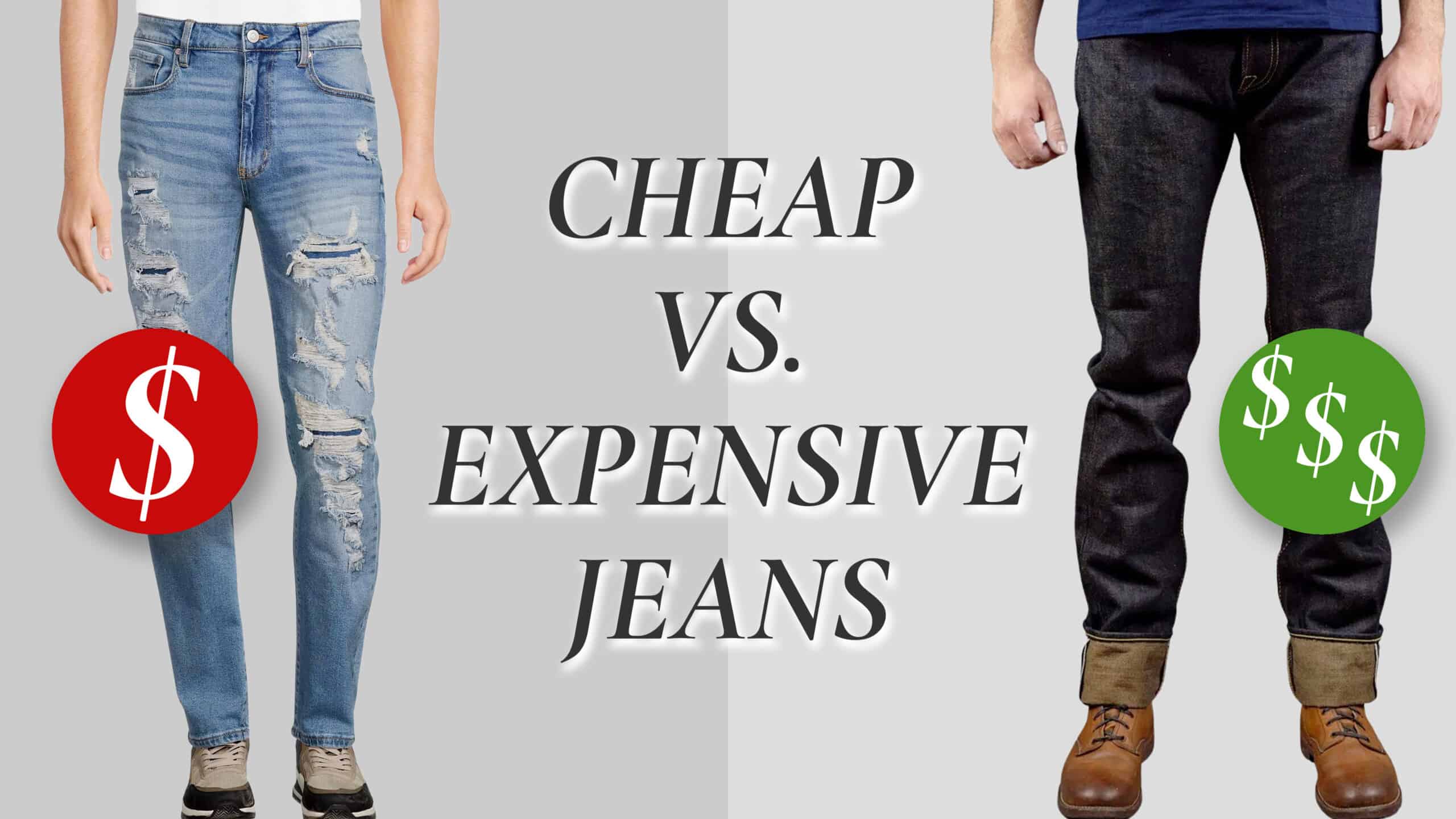

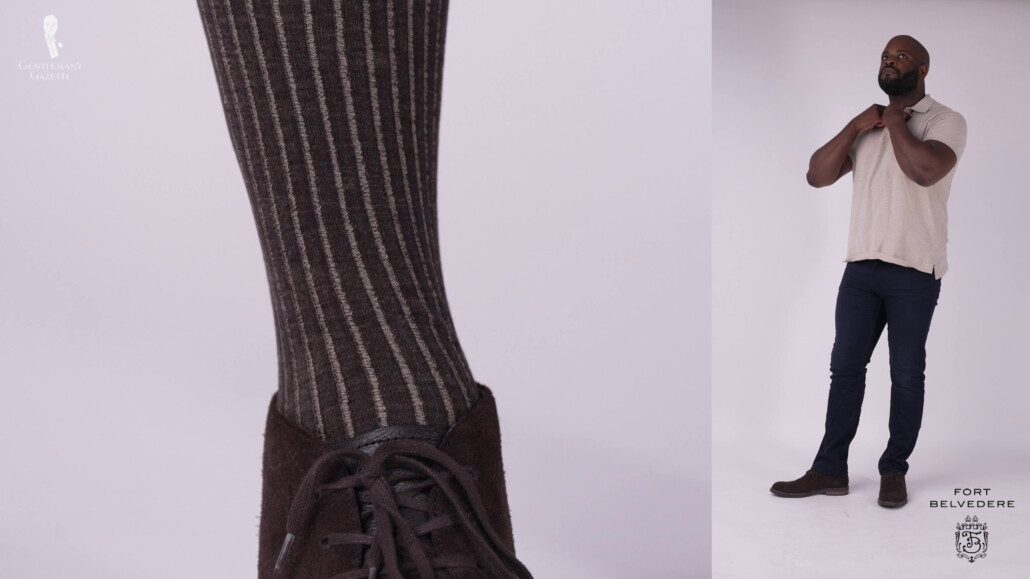
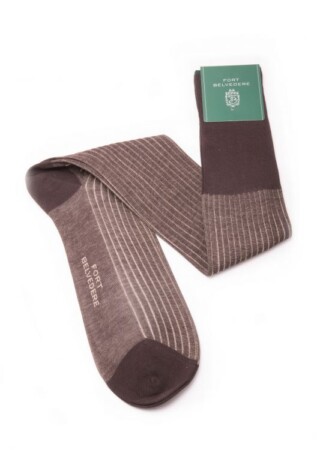
This was an informative article/video. A list of recommended high-end jeans would be appreciated! Specifically, from Japan and the United States.
As none of our hosts (especially Raphael or myself) are terribly frequent wearers of jeans, this is an area that will require more exploration from us–keep an eye out, as we may do a “ranking video” in the future!
Interesting read (as always with the GG)!
Couple of dimensions that I was missing in this article, which make judgement on something as simple as a pair of jeans even more complicated ;-)
– impact on the environment – This is a something that deserves more attention. Use of water, pollution, etc define the impact of the jeans. Brands that recycle cotton and/or water and work with paint and fabrics that have less negative impact should be called out … and this is not just price-based; There are even brands that take your old jeans and recycle – sustainable responsibility
– labour conditions – although more and more manufacturers are becoming more transparent, this is still a major issue. Also some expensive jeans are made under terrible conditions. The brands that are responsible and transparent deserve a big +
– I understand from the article that using fabrics other than cotton is a sign of cheapness and makes the jeans worse. However, most of my jeans (Levi, Armani, AJ, 7 For All Mankind, Seven, Boss, .. are made with elastan. In addition, I see use of Tencel/Lyocel and even polyester in expensive jeans. Some linked to the lower environmental impact these fabrics have … worth a more in depth assessment?
– Should Weight of the fabric be considered?
– Last is the fit and style. Some (expensive) jeans have a very fashionable fit/style that lasts a lot shorter than the fabric of the jeans, which drives waste and higher cost-per-wear.
Looking forward to what you think! I would love to see how you analyse suits and shoes on jeans.
Thank you and greetings from The Netherlands,
Peter
All very good points, Peter! We’ll keep these criteria in mind for future installments of this series. In the meantime, take a look at our article on Building a Green & Sustainable Wardrobe:
https://www.gentlemansgazette.com/how-build-green-sustainable/
My personal experience – and please take it as just that – is, neither Levis nor Wrangler are worth the asking price. I have worn out 501s just as much and in about the same time period as some nondescript bargain jeans. One mans experience.
Have to agree with you Bill. I wore Wranglers for years working in and out of the saddle. The fit and construction quality have definitely changed. I have never bought a pair of fashion jeans, but I have a pair of riders that are cleaned and pressed for some occasions.
Well interesting blog. It reinforced my opinion that anything above $30 is a complete narcissitic indulgance. Levis don’t last any longer than Walmart. The more expensive, often the thinner the material. The whole idea of buying, much less paying extra for jeans with holes in them or worn out knees is a testiment to how marketing can manipulate the weak minded into doing absolutely anything.
I didn’t see the washing guide that’s mentioned.
A link has been added! For your convenience, here’s the post to which we were referring:
https://www.gentlemansgazette.com/cheap-and-easy-laundry-hacks/
I still think of jeans as work cloths, and I always try to buy moderately priced well made jeans that are all cotton. Cheap jeans are just not going to hold up under the strains I put on them. I generally will wear a pair for about five years before they wear out. Unfortunately the brand I have bought for years recently became popular, and the quality has gone down as more hipsters have bought them. Which is a shame as I know need to find a new manufacturer to buy from. And yes, I knew that pocket was for a watch, and I use it that way.
Just checked out a pair of my Lee Jeans, the brand which I been wearing since 1965 (cost $5.00) the rivets are the same as they were then. I love my Lee Jeans.
if you want to try a few alternative fits and finishes without breaking the bank, try iTailor bespoke jeans. The Red Selvedge denim is a good place to start at about $130 (Australian)
The overall quality of nearly all name brand jeans have gone downhill over the past decade. I used to get years of wear out of my jeans back in my high school days, and I was wearing jeans almost everyday! Now that I’m older and my wardrobe has changed to business attire, I don’t wear jeans very often. But nowadays, I’m lucky to get 18 months of life out of a pair of jeans.
Side note: Preston, how long have you been with Gentleman’s Gazette now?
Another side note: These darn pop-ups for the GG store and other GG videos keeps kicking me out of writing my message. It’s incredibly annoying! Please fix this.
Thanks for your comments, James!
Note 1: Just over four years at the time of this writing. :)
Note 2: I’ll bring this to the attention of our web development team. If issues persist, please don’t hesitate to submit a ticket to our helpline, via the link below.
https://www.gentlemansgazette.com/contact/
Good review.
I bought a pair of Tellason “John Graham Mellor” size 36″ raw selvage 14.75 oz. from Sons of Stags in London. I wear a size between 33/34. They cost $240.00. I read that if you buy a pair of raw selvedge jeans to buy 2″ bigger and then soak them in a bathtub of hot water for one hour. This was supposed to dry and be my size. (When I took them out of the package, I could not believe how big they were. I was going to send them back by remembered what the process of sizing with raw selvedge jeans.)
After the jeans were dry, they were still huge. I washed them in the washer machine in hot water. After they dried, they were still big.
I took them to my dry cleaners and had the waist taken in. Horrible job. I took them back to the same place and had the work done again but still too big. I went to a tailor who took them in. They were better but still big in the waist.
They are nice jeans and worth the money. I wished that I bought raw selvedge years ago because I wear items for a long time and my weight hasn’t changed in years, but the price was always a deterrent, and I really didn’t know anything about them.
Recently, I took all the measurements from an old pair of Levi’s that I bought a while ago and might but another pair that fit in the waist.
My mistakes buying raw selvedge jeans were not buying in person and following the advice of sizing when buying raw selvedge jeans.
I usually pay around $30 to $35, but I recently forked over $125 for a pair from Banana Republic that I really like. I only wear them for “dressier” occasions and, yes, I do wear them with a blazer.
Thanks for this article! Very informative. I went looking for jeans a while back both cheap and designer. I discovered that jeans these days have a stretch in the waist, which for me is a huge turn off. I looked at a pair of Lucky Brand but the quality of the denim was less than expected plus the stretch and I was out. I’m willing to spend 100 to 150 on a quality pair of jeans any recommendations?